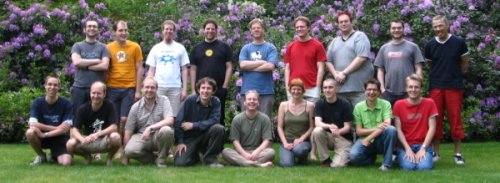Interview with KDE-PIM Hacker Cornelius Schumacher
Our final interview in this series with the hackers at the on-going Dutch KDE PIM meeting is with none other than KDE-PIM module project leader of Cornelius Schumacher. Enjoy the interview.

Cornelius at the KDE PIM Conference
Cornelius please tell us who you are and what your role is in the KDE project.
I have been around for quite a while now. I recently found the first patch I contributed to KDE when looking through old mails. It was a fix for the development version of KOrganizer which made it not crash when starting up. This was during the porting from KDE 1 to KDE 2. Funnily enough I sent the patch to the KOrganizer mailing list exactly on this day six years ago.
My main focus has been KDE PIM from the beginning, but I have also done some stuff in the core libraries and other stuff like maintaining the KDE Help Center.
As my day job I work for SuSE/Novell.
Can you tell us a bit more about what you are currently working on? If you could code 24h a day for six weeks in a row, what would be the thing you would do?
I'm currently working on usability and collecting ideas for KDE 4. I'm also experimenting with some new technology, e.g. Superkaramba. If I could have a couple of weeks of unexpected extra spare time for coding I would probably finish the Kontact port to Windows.
We have seen several developers in interviews and blogs talk about the KDE PIM event in the Netherlands and what they are planning to work on during the meeting. Do you have any plans or ideas for this meeting?
There are two big goals I would like to achieve at the meeting. First, creating a roadmap for KDE PIM 4. Second, relaunching the KDE-PIM web pages with some fresh and rejuvenated content. But I'm sure there will also come up some new ideas at the meeting.
I saw the attendance list of the PIM meeting and it seems that the people attending have had a tight relationship with each other for a while now. Would it good to have some fresh blood in the group?
We always had some people at the KDE PIM meetings which nobody has met in person before. It's true that there is a fairly stable core of people, but it's certainly possible to get fresh blood in the group. This time we for example have Frank Osterfeld of Akregator fame, who is a new member of KDE PIM.
We heard that some usability people are coming. What's their role during the meeting?
That's part of the quest to deeply integrate usability work in the KDE development process. We already had quite some success with it and I think usability has never been as present in the mind of the KDE developers as it is now.
We try to get usability feedback as early in the development process as possible, so that it can really have the impact which is needed to create high-quality user interfaces. Having around the usability people when thinking about KDE PIM 4 will be a great asset. I'm sure that KDE 4 will be the most user friendly KDE ever.
What can we expect from KDE PIM in KDE4? Is there some roadmap?
There are lots of ideas floating around, but we haven't really started the concrete discussion about KDE PIM 4 yet. I expect the we will come up with a first roadmap at the meeting.
What's the status of the submitted RFC GroupDav, a protocol the PIM people came up with during the last meeting together with hackers from Opengroupware.org?
GroupDav is not a formal committee standard. It has been created from the needs for standardization which arose from actually implementing communication between OpenGroupware.org and Kontact. It's meant to be a pragmatic standard, which makes it easy to implement, both on the server side and on the client side without introducing much new technology.
The beauty of GroupDav is that it makes extensive use of existing standards and the existing development infrastructure, so that we can take profit of having the excellent WebDav and HTTP kio slaves and our iCalendar and vCard libraries.
GroupDav has been adopted surprisingly well. There is work going on to add GroupDav support to Evolution and SunBird, the Mozilla calendar project. With Citadel there also is a second server implementation.
Isn't groupware in OSS becoming difficult now that Hula groupware server is supporting CalDav instead of the GroupDav protocol?
Quite the contrary. I think Hula is is a great thing for open source groupware. It's not the first open source groupware server, but it puts the focus on the right aspect, on creating a system which people love to use. This can get the groupware thing out of the dark corporate corner where it currently hides and annoys the people which are forced to use it. To be fair I have to say that Hula is not the only system which is trying to achieve that. Others are doing this as well.
About CalDav I would like to add, that there is no conflict between GroupDav and CalDav. GroupDav can be seen as the continuation of classical iCalendar over HTTP which KOrganizer has supported since version 2.0 (released almost five years ago) and what Apple has tried to make proprietary with their "webcal" protocol. GroupDav is the pragmatic approach to create a protocol which takes more advantage of having a server, providing more fine-grained access and a solid base for syncing and caching data by exploiting the lesser known features of HTTP 1.1. CalDav is one more step. It adds more power, but on the other hand also hasn't the scope of GroupDav, as it only targets calendar data.
Once Hula has usable CalDav support, Kontact will support it. KDE PIM has a track record of implementing server access within days. Hula will be no exception. Let's see how things evolve, but maybe the Hula/Kontact combo will be the killer application which will bring groupware to the common user.
Where do you think KDE PIM shines?
What I like most about KDE PIM is the community. There are lots of great people and if you look at the commit digest KDE PIM usually is the most active KDE core module. It's really fun to be part of this community.
Another aspect is the excellent technology which has emerged from KDE PIM. It always has been a breeding ground for new KDE technology. For example KConfig XT or KNewStuff were born in KDE PIM.
Finally, there is Kontact which is a real killer application. It's kind of the essence of KDE PIM. I really enjoy all the nice comments and good feedback about Kontact. The best thing about Kontact from a developers perspective is that it has a very solid architecture. This provides the potential to quickly adapt to whatever future requirement will arise.
What part of KDE PIM needs some serious attention?
As a user I would put my attention on Kontact. That's where most of the exciting stuff will happen.
If your question is asking which areas of KDE PIM I think needs work, I would mention the KMail internals. Mail still is the heart of personal information management and systems like Gmail show that there can be quite some innovation in this area. Although it has improved significantly recently, the core of KMail still needs some work to make it as flexible as it could be, so that we can better focus on providing a usable, innovative and polished user interface.
But all the developers of KMail are already working as hard as they can, as far as I can judge. How do you see that is going to happen?
It's not about creating extra work. Cleaning up the code will quickly save us work, because it allows us to implement new features with less effort and do bug fixes faster and more reliable. Constant refactoring is an essential part of open source development, especially in KDE. KDE 4 will provide us with the opportunity to do some of the stuff we havn't dared to touch in the past because we will have to work on the code for Qt4/KDE4 porting anyways.
What future do you see for KDE PIM?
Well, I don't have my crystal ball at hand, but I feel that the future of KDE PIM will be bright ;-)
So another thing we heard is that you are leaving to go to GUADEC in Germany. Could you tell us more about that? Any more KDE people going to be there?
Some people have asked me, why are you going to GUADEC, aren't you a KDE guy? I tell them, yes, I'm a KDE guy and that's why I'm going to GUADEC. GNOME and KDE are the dominant desktop projects on Linux and other Unix systems. We have the same goals and there are lots of areas where we can work together. We should jointly go for the 98 percent of Windows desktops out there and not fight each other. A bit of healthy competition is quite useful though.
I will meet some people on GUADEC to talk about cooperation and standardization. One topic is a common documentation standard, another is syncing. There certainly will be others.
There will be a number of other KDE people at GUADEC. Have a look at the KDE Wiki for more details.
More photos of the conference are available on kde.nl.
